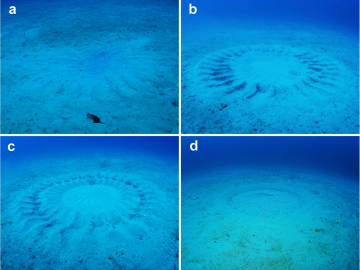721124_Fishy Art_360 px width.png

Progression of a circular nest from start to finish, made by male pufferfish in the sand. Credit: Y. Okata, CC BY-NC-ND 3.0
Pufferfish in Japan are known for one thing. They’re a delicacy that can be deadly. Their organs contain a highly toxic compound that can kill in minutes. But one species of pufferfish has a different distinction: Its males might be the most creative artists in the oceans.
In 1995, divers off the coast of Japan saw an unusual pattern in the sand on the ocean floor—a circle with small peaks and valleys radiating out from a flat center. It wasn’t until 2011 that marine scientists could explain them: the creations of a species known today as white-spotted pufferfish.
The fish is only a few inches long, but its creations can span more than seven feet. They’re nests—sculpted by males to attract females.
The male begins the process by creating a circle. He swims back and forth across it, flapping his fins to carve ridges and valleys. They radiate outward from the center in near-perfect lines. The fish then creates smaller ridges inside that structure, with a flat area in the middle. Finally, he adds bits of shell and coral. The whole process takes seven to nine days.
When the nest is about ready, a female swims up to it. If she enters, the male rushes toward her. If the female likes the set-up, she lays her eggs in the center—then vanishes. The male spends up to six days protecting the eggs as the nest slowly erodes in the currents. He doesn’t shore it up. Instead, after the young’uns are gone, he starts a new one—a new work of art at the bottom of the sea.

